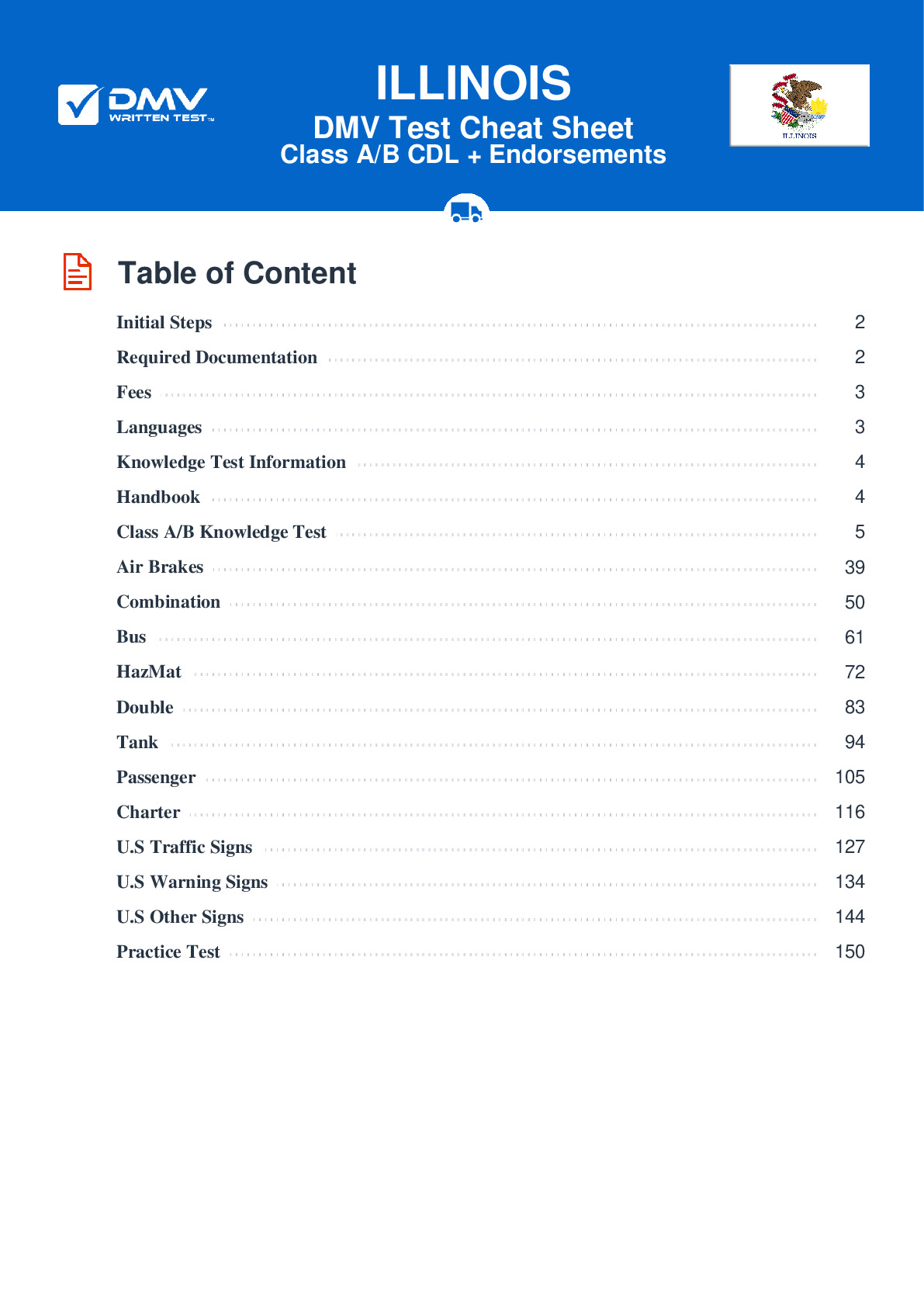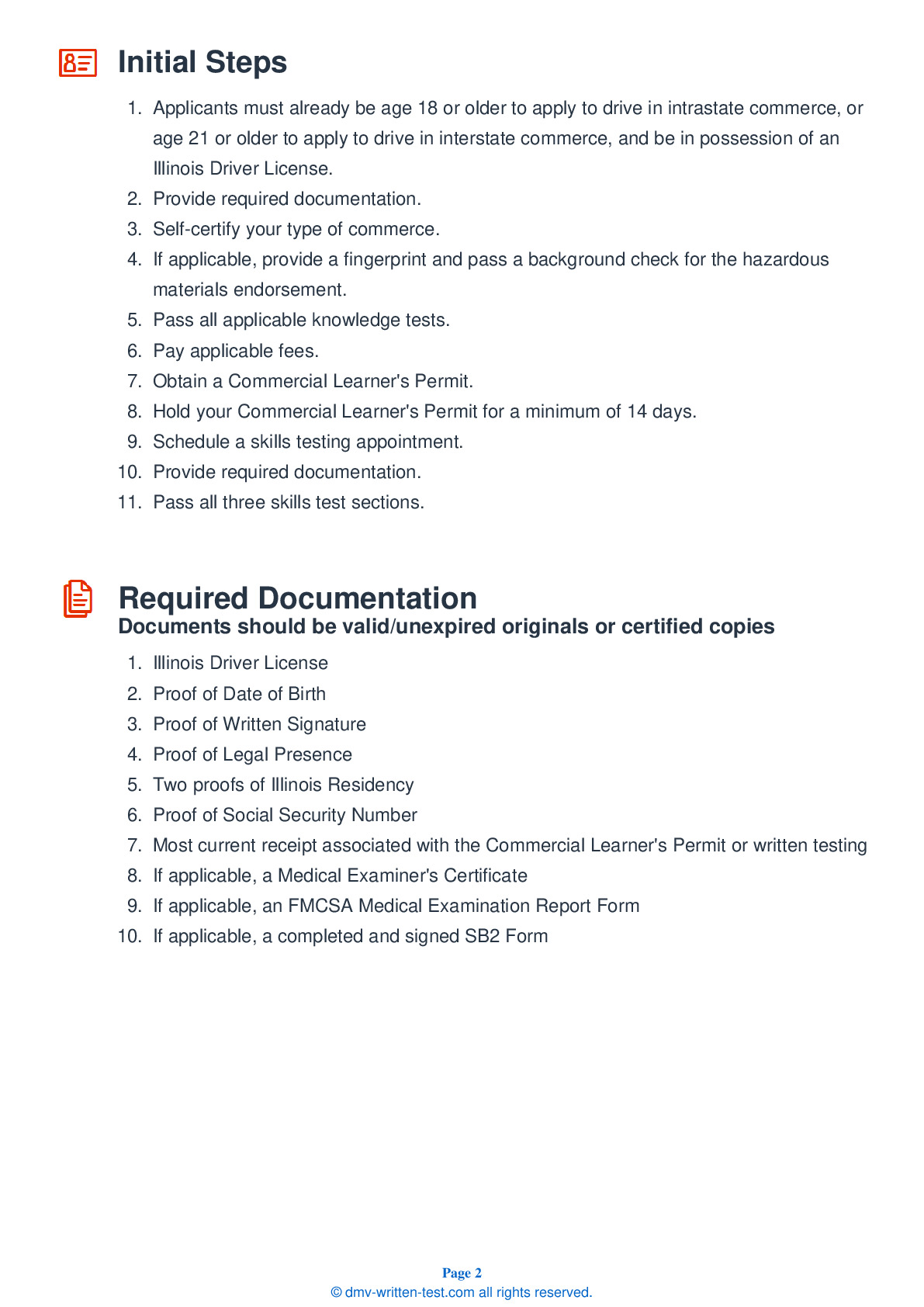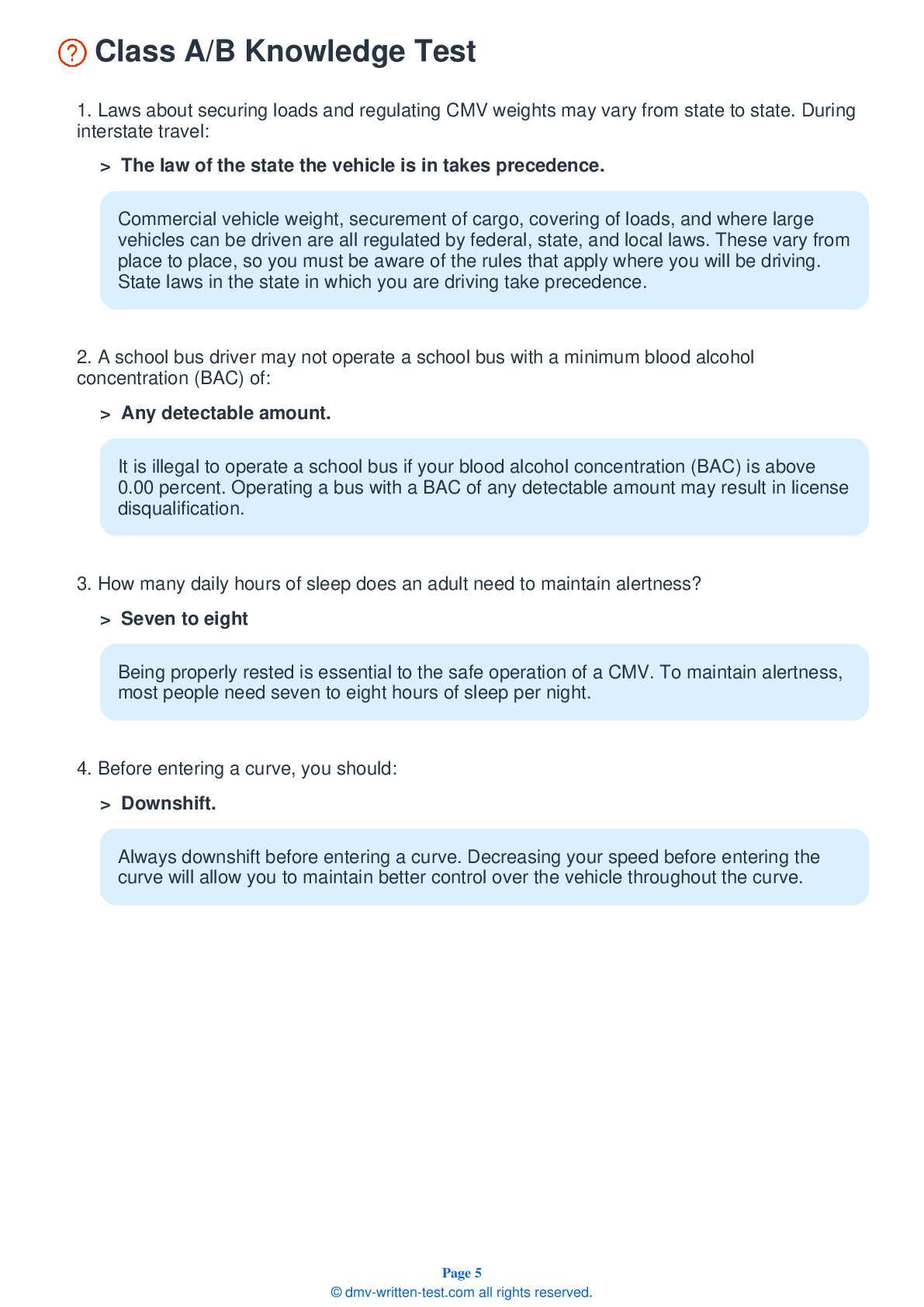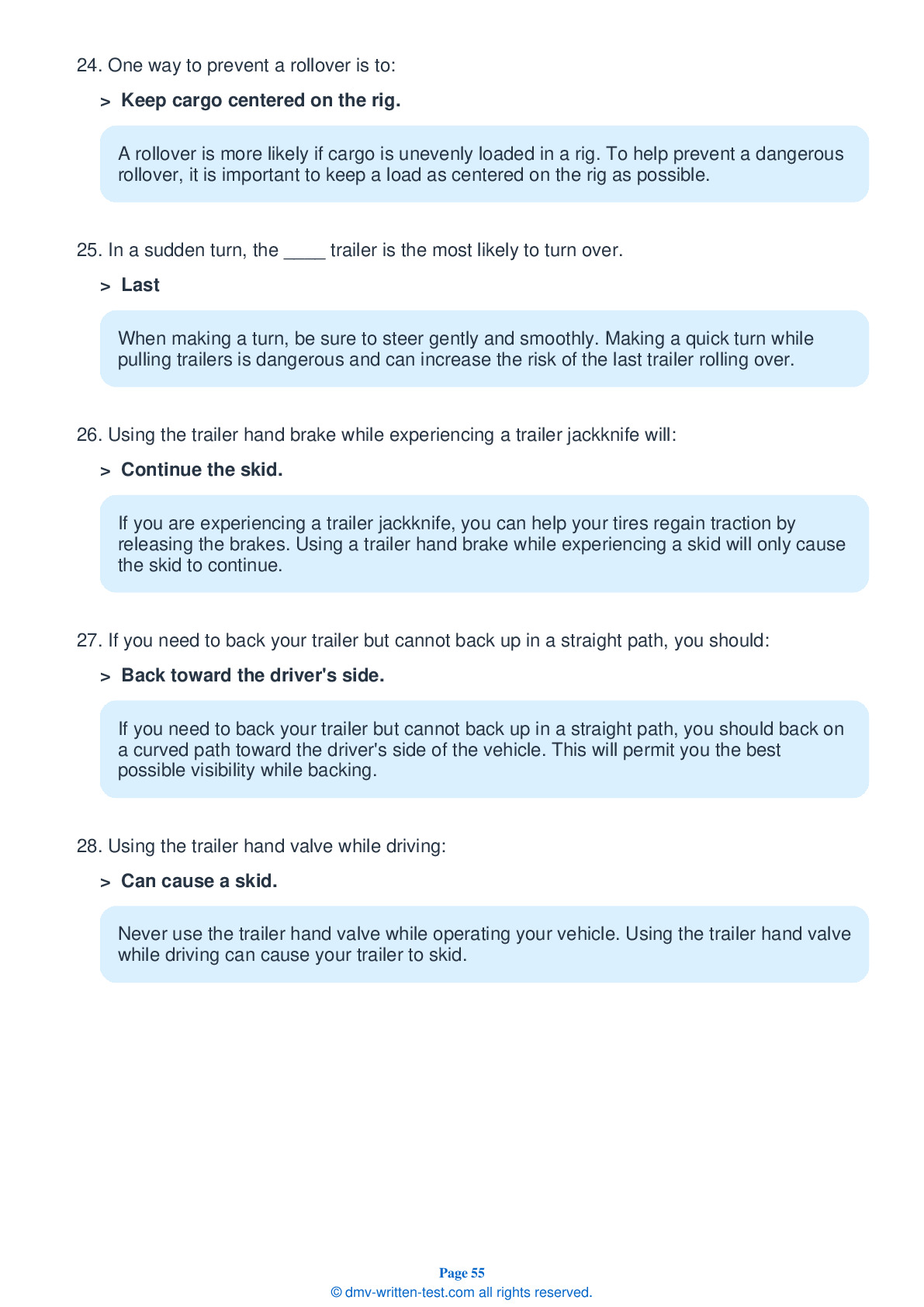Knowledge Test Class A
This license is required for driving any legal combination of vehicles, with a gross combination weight rating of 26,001 pounds or more, provided the GVWR of a trailer exceeds 10,000 pounds. To receive this license, applicants must pass a 50-question test. Test questions come from the Illinois Commercial Drivers License Study Guide. To pass, applicants must answer 40 questions correctly. Questions come from chapters covering: Introduction, Driving Safely, Transporting Cargo Safely, Air Brakes (if applicable), Combination Vehicles, Pre-Trip Vehicle Inspection Test, Basic Vehicle Control Skills Test and On-Road Driving. Endorsements that may be used with a Class A CDL are: Hazardous materials, Tank, Passenger, Doubles/Triples, HazMat, Tank, Air Brakes, School bus and Charter.
22. Tread depth in the major grooves on a front tire should be at least:
Tires need to have at least 4/32 of an inch of tread depth in every major groove on the front tires, and at least 2/32 of an inch of tread depth on other tires.
23. Cargo on flatbed trailers should be:
Cargo on flatbed trailers or trailers without sides must be tied down to prevent it from shifting or falling in transit.
24. When taking the on-road driving test, you must do all of the following, except:
During the on-road driving test, you must drive in a safe and responsible manner; wear your safety belt; obey all traffic signs, signals, and laws; and complete the test without any accidents or moving violations.
25. How is the parking brake released?
In newer vehicles with air brakes, the parking brakes are controlled by a diamond-shaped yellow knob. Pull the knob out to activate the parking brakes and push it in to release them.
26. When approaching a curve during the on-road driving test, you must do all of the following, except:
When approaching a curve during the on-road driving test, you should thoroughly check traffic in all directions. Before entering the curve, reduce your speed sufficiently so that further braking or shifting is not required. Keep your vehicle in its lane and continue checking traffic in all directions.
27. When stopped on the side of the road, the driver should:
If you must stop on the side of the road, it is important to turn on your four-way emergency flashers to warn other road users.
28. A thin layer of ice that forms on road surfaces is called:
Black ice is a thin layer of ice that is clear enough for the road surface to be seen through it. A road covered in black ice may look like it is merely wet. You should be very careful when temperatures are below freezing and the road looks wet.
Frequently Asked Questions
To obtain a Class A CDL license in Illinois, you must:
1. Be at least 18 years old (21 years old for interstate driving).
2. Have a valid Illinois driver’s license.
3. Provide proof of citizenship or legal presence in the United States.
4. Pass a vision test.
5. Obtain a medical certificate from a certified medical examiner.
6. Pass a knowledge test and a skills test in accordance with Federal Motor Carrier Safety Administration (FMCSA) standards.
It is recommended that individuals participate in a CDL training program to prepare for the knowledge and skills tests. Once you have passed the tests, you will be issued a Class A CDL license by the Illinois Secretary of State.
1. Combination vehicles with a total weight of 26,001 or more pounds, provided that the vehicle being towed weighs more than 10,000 pounds.
2. Tractor-trailers
3. Truck and trailer combinations
4. Livestock carriers
5. Flatbeds
6. Tanker vehicles
7. Double and triple trailers
It is important to note that with a Class A CDL license, you can also operate vehicles in Class B and Class C categories such as buses and passenger vans depending on the specific endorsements you have obtained.
1. Be at least 18 years old (21 years old for interstate driving).
2. Have a valid Illinois driver’s license.
3. Provide proof of citizenship or legal presence in the United States.
4. Pass a vision test.
5. Obtain a medical certificate from a certified medical examiner.
6. Pass a knowledge test and a skills test in accordance with Federal Motor Carrier Safety Administration (FMCSA) standards.
In addition to the above requirements, you may also need to obtain specific endorsements based on the type of vehicle you will be operating and the cargo you will be carrying. For example, you may need to obtain a Hazmat endorsement if you will be carrying hazardous materials.
It is recommended that individuals participate in a CDL training program to prepare for the knowledge and skills tests. Once you have passed the tests and obtained any necessary endorsements, you will be issued a Class A CDL license by the Illinois Secretary of State.
For interstate driving, which means driving across state lines, the minimum age requirement is 21 years old.
It is important to note that there may be additional age requirements for specific endorsements, such as hazardous materials or passenger endorsements.
1. Hazmat endorsement: Required for drivers who will be transporting hazardous materials.
2. Tanker endorsement: Required for drivers who will be operating vehicles that transport liquids or gases in bulk containers.
3. Double/triple trailer endorsement: Required for drivers who will be operating double or triple trailer vehicles.
4. Passenger endorsement: Required for drivers who will be transporting passengers, such as in a bus.
5. School bus endorsement: Required for drivers who will be operating a school bus.
To obtain an endorsement, you must pass a knowledge test specific to the type of endorsement you are seeking. Some endorsements may also require additional skills tests or background checks. It is important to note that some employers may require specific endorsements, so it is important to research and understand the requirements of your potential employer.
1. Pre-trip inspection test: In this part of the skills test, you will be asked to inspect your vehicle to make sure that it is safe to operate. You will be asked to check various parts of the vehicle, such as the brakes, lights, and tires, and explain to the examiner what you are checking and why.
2. Basic vehicle control test: In this part of the skills test, you will demonstrate your ability to control your vehicle in a variety of situations. This may include backing up, turning, and parking your vehicle.
3. Road test: In this part of the skills test, you will be asked to drive your vehicle on public roads while demonstrating your ability to safely operate it. The examiner will be looking for your ability to follow traffic laws, make safe turns, change lanes properly, and safely interact with other drivers on the road.
It is important to note that the specific details of the Class A CDL skills test may vary depending on the state or jurisdiction where you are taking the test. However, these three parts are generally included in most Class A CDL skills tests.
1. Age restrictions: To obtain a Class A CDL license, you must be at least 18 years old. However, drivers under the age of 21 are limited to driving within the state of Illinois and cannot transport hazardous materials.
2. Endorsement restrictions: As mentioned before, specific endorsements may be required for certain types of vehicles or cargo. If you do not have the required endorsement, you may be restricted from operating certain vehicles or carrying certain types of cargo.
3. Vehicle restrictions: Some vehicles may require additional training or certification to operate, such as vehicles with air brakes or double/triple trailers. If you do not have the proper training or certification, you may be restricted from operating these types of vehicles.
4. Medical restrictions: Drivers with certain medical conditions may be restricted from driving certain types of vehicles or carrying certain types of cargo. It is important to maintain a valid medical certificate and inform your employer of any medical conditions that may affect your ability to drive safely.
It is important to understand and comply with all restrictions and limitations that apply to your Class A CDL license to ensure safe and legal operation of commercial motor vehicles.
To take the test in a language other than English, you will need to inform the Secretary of State's Office when you schedule your appointment for the written test. You may also need to provide additional documentation, such as a translation of your driver's license or other identification.
It is important to note that while you may be able to take the written test in a language other than English, you will still need to demonstrate proficiency in English to obtain a CDL. This means that you will need to be able to read and understand road signs and communicate with law enforcement officers and other drivers in English.
If you have any questions or concerns about taking the Class A CDL written test in a language other than English, it is recommended that you contact the Secretary of State's Office for more information.
To request accommodations for the written test, you will need to complete and submit the Request for Accommodation of Disability form, which is available on the Secretary of State's website. The form requires you to provide information about your disability and the specific accommodations you are requesting, such as extra time or a separate testing room.
You will also need to provide documentation from a licensed healthcare professional that verifies your disability and supports your request for accommodations.
Once your request and documentation have been received and reviewed, the Secretary of State's Office will work with you to determine what accommodations can be provided. The office will make every effort to provide reasonable accommodations that do not fundamentally alter the nature of the test or give you an unfair advantage over other test takers.
It is important to note that requests for accommodations must be submitted well in advance of your scheduled test date in order to allow sufficient time for review and implementation of accommodations. If you have any questions or concerns about requesting accommodations for the Class A CDL written test, it is recommended that you contact the Secretary of State's Office for more information.
For most CDL endorsements, you are allowed to retake the written test twice within a 12-month period, but you must pay a fee for each attempt. If you fail the test three times within a 12-month period, you will be required to wait at least 14 days before attempting to retake the test again.
However, if you are seeking a Hazardous Materials (HazMat) endorsement, the rules are more strict. You are only allowed to take the HazMat written test once per day, and if you fail it, you must wait at least 24 hours before attempting to retake it. Additionally, if you fail the HazMat written test three times within a 12-month period, you will be required to wait at least 30 days before attempting to retake it again.
It is important to note that if you fail the written test multiple times, it may be beneficial to seek additional training or resources before attempting to retake the test again. The Illinois Secretary of State's Office offers a CDL study guide and practice tests on its website that may be helpful in preparing for the written test.
If you have any questions or concerns about retaking the Class A CDL written test in Illinois, it is recommended that you contact the Secretary of State's Office for more information.




